Corps is a term used for several different kinds of organization. A military innovation by Napoleon, the formation was first named as such in 1805. The size of a corps varies greatly, but from two to five divisions and anywhere from 40,000 to 80,000 are the numbers stated by the US Department of Defense.
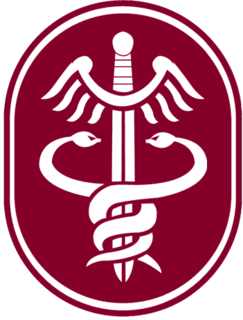
The U.S. Army Medical Command (MEDCOM) is a direct reporting unit of the U.S. Army that formerly provided command and control of the Army's fixed-facility medical, dental, and veterinary treatment facilities, providing preventive care, medical research and development and training institutions. On 1 October 2019, operational and administrative control of all military medical facilities transitioned to the Defense Health Agency.

The United States Public Health Service Commissioned Corps (PHSCC), also referred to as the Commissioned Corps of the United States Public Health Service, is the federal uniformed service of the U.S. Public Health Service (PHS), and is one of the eight uniformed services of the United States. The commissioned corps' primary mission is the protection, promotion, and advancement of health and safety of the general public.

USNS Comfort (T-AH-20) is a Mercy-class hospital ship of the United States Navy.

The Dental Corps of the United States Navy consists of naval officers who have a doctorate in either dental surgery (DDS) or dental medicine (DMD) and who practice dentistry for Sailors and Marines to ensure optimal oral health.

The Royal Canadian Medical Service is a personnel branch of the Canadian Armed Forces, consisting of all members of medical occupations. Nearly all members of the RCMS, along with the members of the Royal Canadian Dental Corps (RCDC), are employed in the Canadian Forces Health Services Group, an operational formation. The RCMS was formerly designated the Canadian Forces Medical Service until it was redesignated on October 9, 2013.
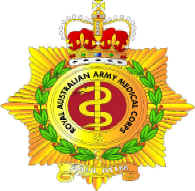
The Royal Australian Army Medical Corps (RAAMC) is the branch of the Australian Army responsible for providing medical care to Army personnel. The AAMC was formed in 1902 through the amalgamation of medical units of the various Australian colonies and was first deployed to South Africa as a small detachment of personnel supporting the Australian Commonwealth Horse during the Second Boer War. The corps has participated in every Australian Army operation since then, including wars and peacekeeping operations. The "Royal" prefix was granted in 1948.
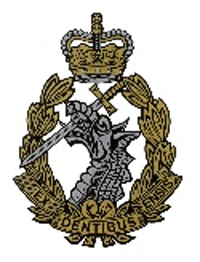
The Royal Army Dental Corps (RADC) is a specialist corps in the British Army that provides dental health services to British Army personnel and their families in war and in peace. The corps is a part of the British Army's Army Medical Services.

The Royal Army Veterinary Corps (RAVC), known as the Army Veterinary Corps (AVC) until it gained the royal prefix on 27 November 1918, is an administrative and operational branch of the British Army responsible for the provision, training and care of animals. It is a small corps, forming part of the Army Medical Services.

The Army Medical Department of the U.S. Army (AMEDD), formerly known as the Army Medical Service (AMS), encompasses the Army's six medical Special Branches. It was established as the "Army Hospital" in July of 1775 to coordinate the medical care required by the Continental Army during the Revolutionary War. The AMEDD is led by the Surgeon General of the U.S. Army, a lieutenant general.
The Royal New Zealand Army Medical Corps (RNZAMC) is a corps of the New Zealand Army, the land branch of the New Zealand Defence Force (NZDF). The Medical Corps provides for the medical needs of soldiers, such as diagnosing and treating diseases and injuries. Medical personnel are part of almost all Army exercises and operations, and personnel work in conjunction with personnel from the Royal New Zealand Dental Corps and the Royal New Zealand Nursing Corps.
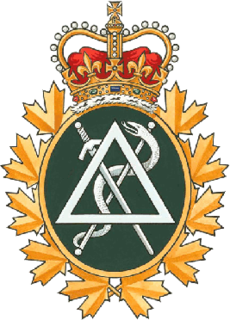
The Royal Canadian Dental Corps is a personnel branch of the Canadian Armed Forces (CAF). Most members of RCDC, along with the members of the Royal Canadian Medical Service, are employed in the Canadian Forces Health Services Group within the Military Personnel Command reporting to the Chief of Military Personnel. The branch was previously named the Dental Branch from 1968 to 2013.
A medical corps is generally a military branch or officer corps responsible for medical care for serving military personnel. Such officers are typically military physicians.

The term military medicine has a number of potential connotations. It may mean:
The 1st Close Health Battalion (1CHB) was a unit of the 17th Sustainment Brigade of the Australian Army. It headquartered at the Robertson Army Barracks in Darwin, but had sub-units located in Darwin, Townsville and Brisbane. The unit traced its lineage back to the 1st Field Hospital, which was raised in the 1960s for service as part of Australia's contribution to the Vietnam War. Since then, the unit has changed names twice and personnel have been deployed on numerous peacekeeping and warlike operations throughout Africa, the Middle East and the Asia-Pacific region. The 1st Close Health Battalion disbanded in December 2021 however lives on through the ‘’’1st Health Battalion (1HB)’’’ who have retained the bat symbol. It’s companies have now become their own Battalions excluding 8CHC who was absorbed into 1HB. 8CHC is now 1HB, 11CHC is now 2HB, 8CHC/7PL is now 3HB and 2CHC is now 4HB.
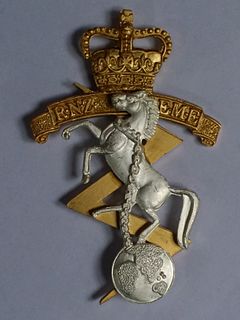
The Royal New Zealand Electrical and Mechanical Engineers (RNZEME) was a New Zealand Army Corps comprising Army trained tradesmen (craftsmen) who repaired Army equipment wherever New Zealand Forces served.
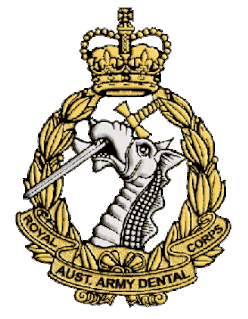
The Royal Australian Army Dental Corps (RAADC) is a corps within the Australian Army. It was formed on 23 April 1943 during World War II as the Australian Army Dental Corps, before being granted the 'Royal' prefix in 1948. Prior to its formation dentists were part of the Australian Army Medical Corps. The role of the RAADC is to provide dental care to army personnel in order to minimise the requirement for the evacuation of dental casualties, to conserve manpower and to reduce the burden of casualty evacuation. In the post-war years, the corps has provided personnel to deployments in Japan, Korea and Vietnam. It has also contributed to peace-keeping operations in Somalia, Rwanda, Bougainville and East Timor.
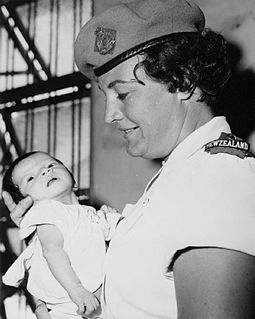
The Royal New Zealand Nursing Corps (RNZNC) is a corps of the New Zealand Army. The corps was initially formed in 1915 from civilian nurses who volunteered for service during World War I, and who were granted honorary officer ranks. A Nursing Reserve had been formed as part of the New Zealand Medical Corps on 14 May 1908. Today, the corps is an officer-only corps that consists of commissioned officers who are employed for their specialist skills and knowledge as registered nurses, the corps works in conjunction with the Royal New Zealand Army Medical Corps and the Royal New Zealand Dental Corps to promote "health and disease prevention" and to provide "care for the wounded and sick". Nursing Officers in the New Zealand Army can be employed broadly in primary health, perioperative, surgical or emergency settings, which can see RNZNC personnel providing health services in a garrison health centre, in a civilian practice, or deployed on operations.

2nd Medical Brigade is a formation of the British Army formed under 1st UK Division. It predominantly provides deployed hospital care via 13 Field Hospitals. It also provides specialist medical capabilities via three Nationally Recruited Units; 306 Hospital Support Regiment, 335 Medical Evacuation Regiment and Medical Operational Support Group.
The 3rd Health Support Battalion is an Australian Army Reserve unit headquartered in Adelaide, South Australia, with sub-units spread across Victoria, Tasmania, South Australia, New South Wales and Queensland. Drawing its lineage from the 3rd Australian General Hospital, which was raised for service during World War I, the unit is tasked with providing Role 2 health support to troops deployed overseas on operations and within Australia on exercise, and has provided medical personnel for a variety deployments in the post-war period, including those to Rwanda, Bougainville, East Timor, Iraq and Afghanistan.















